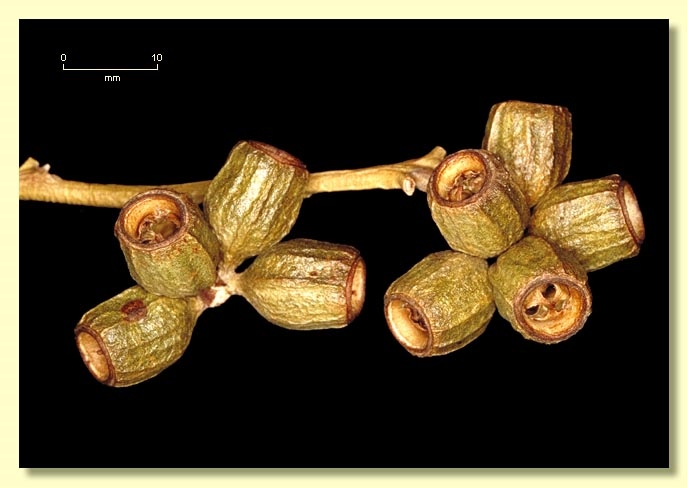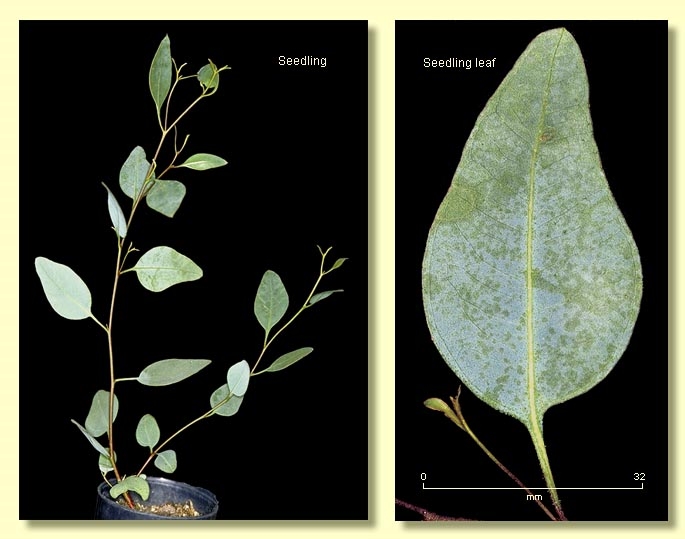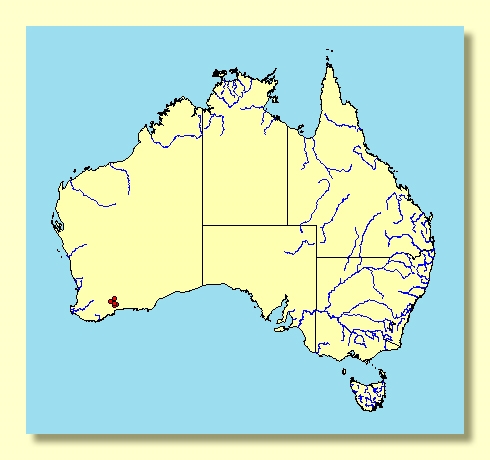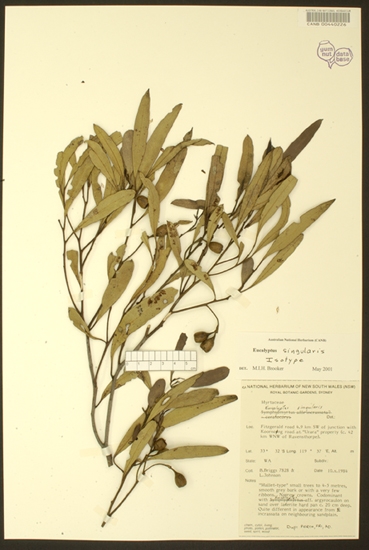Eucalyptus | Symphyomyrtus | Dumaria | Incrassatae
Euclid - Online edition
Eucalyptus singularis
T: Western Australia, Fitzgerald Road, 4.9 km SW of the junction with Koornong Road, at “Urara” property rd, c. 42 km WNW of Ravensthorpe (33°32S, 119°37E), 10 Oct. 1984, B.G.Briggs 7828 & L.A.S Johnson; holo: NSW; iso AD, CANB, PERTH.
Bark smooth throughout or with persistent rough grey to brown ribbons on base of trunk extending for ca 1 m; smooth bark grey-brown or pale grey, sometimes with a few ribbons on the upper branches.
Branchlets with oil glands in the pith, or lacking them.
Juvenile growth (coppice or field seedlings to 50 cm): stems usually rounded in cross-section; juvenile leaves alternate, petiolate, elliptic to ovate, 4–10 cm long, 2–5 cm wide, dull, blue-green, becoming green, glossy at upper nodes.
Adult leaves alternate, petiole 0.8–2 cm long; blade lanceolate to narrowly so, 5.5–13 cm long, 0.6–2 cm wide, base tapering to petiole, entire (marginal lenticels sometimes present but margin not conspicuously toothed), concolorous, glossy, green, side-veins at an acute or wider angle to midrib, densely to very densely reticulate, intramarginal vein parallel to and remote from margin, oil glands intersectional.
Inflorescence axillary unbranched, peduncle slender but apically flattened, pendulous, 1.5–3 cm long; buds 7 per umbel (rarely 3), pedicellate, pedicels 0.5–1 cm long. Mature buds ± cylindrical (1.5–2.5 cm long, 0.5–0.6 cm wide), green to yellow or red-brown, usually with longitudinal ribs, scar present (outer operculum shed early in bud development), inner operculum strongly beaked (0.8–1.6 cm long), stamens inflexed, anthers more or less cuboid, versatile, dorsifixed, dehiscing by longitudinal slits, style long, stigma tapered, locules 3 or 4, the placentae each with 6 vertical ovule rows. Flowers pale yellow.
Fruit pedicellate, pedicels 0.4–0.9 cm long, cylindrical to barrel-shaped, 1–1.5 cm long, 0.8–1.4 cm wide, usually ribbed longitudinally, disc descending vertically, valves 3 or 4, enclosed or just below rim level.
Seed dark grey-brown to blackish, 2–4 mm long, flattened-pyramidal with marginal flange and ribs ascending to hilum which is ventral or almost terminal.
Cultivated seedlings (measured at ca node 10): cotyledons reniform; stems rounded in cross-section; leaves always petiolate, opposite for 3 or 4 nodes then becoming alternate, ovate, 4–6 cm long, 2–3.5 cm wide, dull grey-green.
Flowering has been recorded in November and December.
A mallet endemic to Western Australia, restricted to an area north-west of Ravensthorpe towards Lake Magenta and also at Dragon Rocks and near Dumbleyung. The bark is smooth or scruffy with coarse, imperfectly shed ribbons on the lower trunk, the adult leaves are glossy green and moderately narrow, and the prominently beaked buds are pendulous.
In the classification of Brooker (2000) the more recently published Eucalyptus singularis would belong in Eucalyptus subgenus Symphyomyrtus section Dumaria because the branchlets have pith glands, buds have two opercula, stamens are strongly inflexed, ovules are in six rows on the placentae and cotyledons are reniform. Within section Dumaria, E. singularis, E. incrassata, E. angulosa, E. captiosa and E. ceratocorys are closely related and form series Incrassatae .
The recently described species E. singularis has prominently beaked buds that are always in pendulous clusters on slender peduncles, and leaves variable in width but tending to be fine-leaved like E. captiosa. The narrow-leaved and small-budded subcoastal mallee, E. captiosa, and the coarse-leaved inland mallee with buds narrowed in the middle, E. ceratocorys, both have prominently beaked opercula. E. angulosa is a mallee largely of coastal headlands and dunes, with very coarse leaves, buds and fruits. E. incrassata, with slightly smaller, less prominently ribbed buds and fruits, is subcoastal to inland in distribution as a component of mallee communities.
















